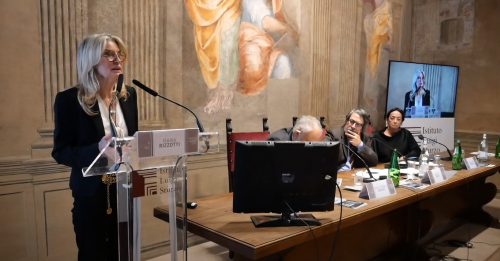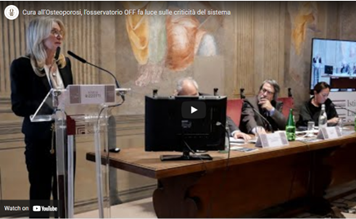In Italy, Osservatorio Fratture da Fragilità addresses the gaps in secondary fracture prevention

Last month, the Fragility Fracture Observatory (Osservatorio Fratture da Fragilità) in Italy hosted a top-level symposium which highlighted the urgent need to address critical gaps in the optimal pharmacological treatment of osteoporosis. Currently, more than 70% of Italian patients aged over 50 years who have suffered a fragility fracture are not receiving any type of medical treatment or therapies to prevent the far too many frequent cases of refractures.1
View Video of symposium in Rome, May 17, 2022
https://www.youtube.com/watch?v=d_g6ITkiMds&t=22s
In a report highlighting the Symposium, published on the Osservatorio website, Senator Maria Rizzotti, president of the Parliamentary Intergroup for Fragility Fractures, stated: “Very often when an elderly person falls, it is said that ‘he fell and his hip broke’. It is not recognized that the femur broke and the person fell, precisely because of the fragility of the bones of which he never suspected."
Bone fragility brings with it many and serious consequences – yet it has in the past been inexplicably and unjustly relegated to the margins of the priorities of Italy’s health agenda.
"Little importance is given to the fact that osteoporosis is followed sooner or later by a fracture, which can be followed by a second fracture especially in the first and second year,” said Dr Achille Patrizio Caputi, Professor Emeritus of Pharmacology at the University of Messina.
Fragility fractures also have an enormous impact on the Italian health care system both in economic terms and in terms of their impact on the structures themselves.
"Patients with fragility fractures occupy most of our wards in our operating theatres, with enormous costs in terms of clinical management and also post-operative management," stated Dr. Francesco Falez, vice president of the Fragility Fracture Observatory.
Professor Maria Luisa Brandi, president of the Fragility Fracture Observatory pointed out the gaps and critical challenges that persist, adding: "There is a problem but it is not recognized, we have epidemiological data but we do not use them, we have pharmacoeconomic data but we do not use them, and the data we have in house within the regions are not read to bring understanding of the problem and therefore to allocate the necessary resources. The Fragility Fracture Observatory aims to highlight the issues and to provide decision-makers with incontrovertible means to intervene in an area that is neglected and forgotten. We will bring the problem of bone fragility to the forefront.”
In Italy, it is estimated that fragility fractures cost € 9.45 billion a year, of which €5.44 billion are used in the direct treatment of the fracture and more than €3.75 billion for long-term disability costs. Only 250 million are used for drugs that treat the 'osteoporosis’. Dr Maria Rizzotti, concluded: “What does this mean? That there is a lack of information, because if we increased the rate of drug treatment following an early diagnosis, I believe that the expense for hospitalization and consequent reduction of fracture would automatically decrease."
About the Osservatorio Fratture da Fragilità
The Fragility Fractures observatory was founded in 2020 in order to bring to the forefront the many critical issues related to the treatment of osteoporosis and to provide health service managers with the conditions and a framework of certainties both instrumental and resource-wise, in which they can effectively. Its first purpose is to collect data, analyses and knowledge: elements that are then coordinated so as to promote initiatives that are useful for the skeletal health of citizens, providing certain and organic answers.
The data collected and processed also enables the Observatory to take on a stimulating role for politicians and health managers locally. The availability of updated and complete data, together with effective communication activities, are an indispensable support for health-related decision-makers which can help them to devise new health policies which can effectively combat the problem of fragility fractures in Italy.
To learn more, visit the website: https://osservatoriofratture.it/
1. SCOPE Italy https://www.osteoporosis.foundation/scope-2021
View facts and statistics here:
https://www.osteoporosis.foundation/sites/iofbonehealth/files/scope-2021/Italy%20Infographic.pdf
